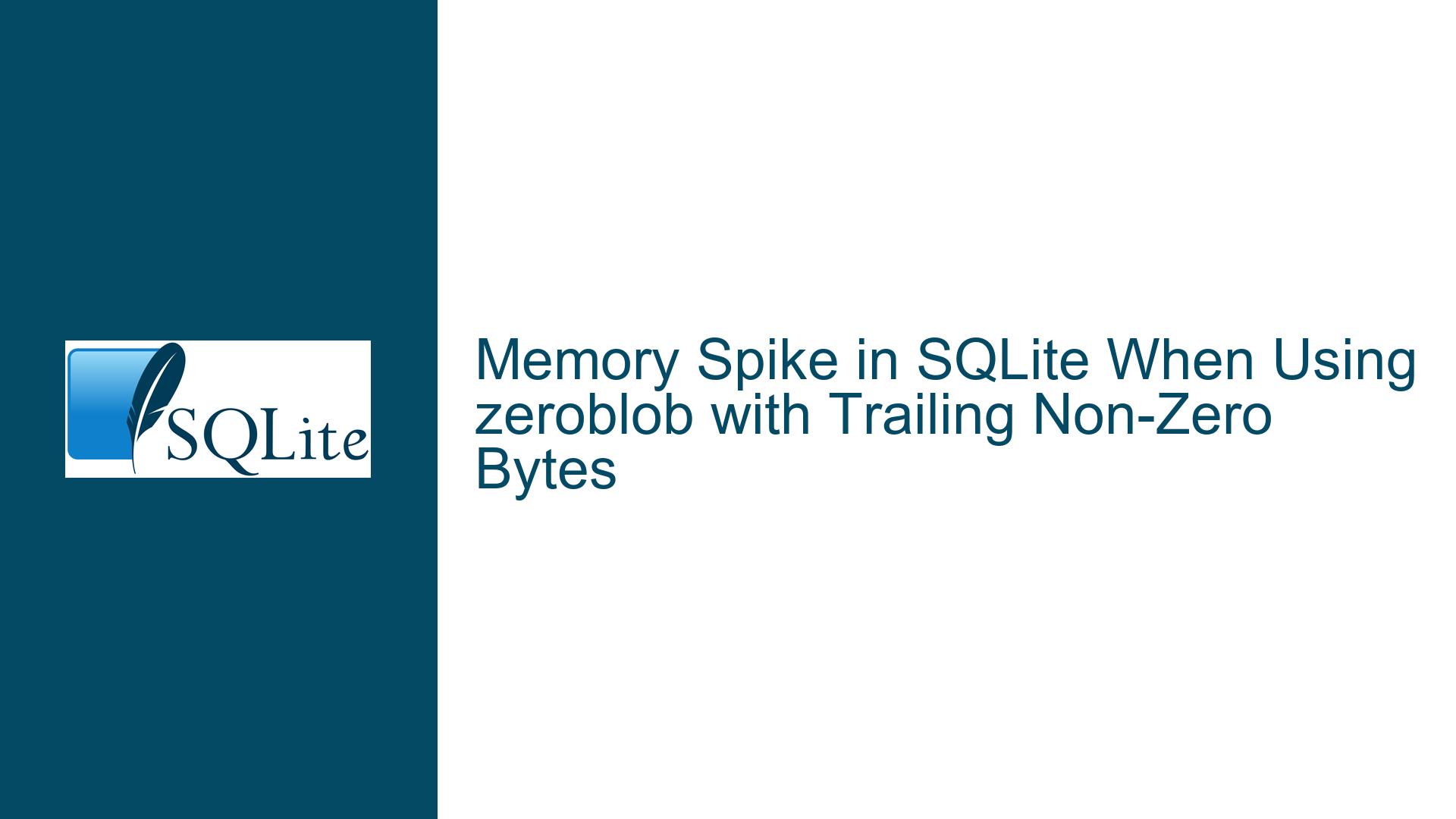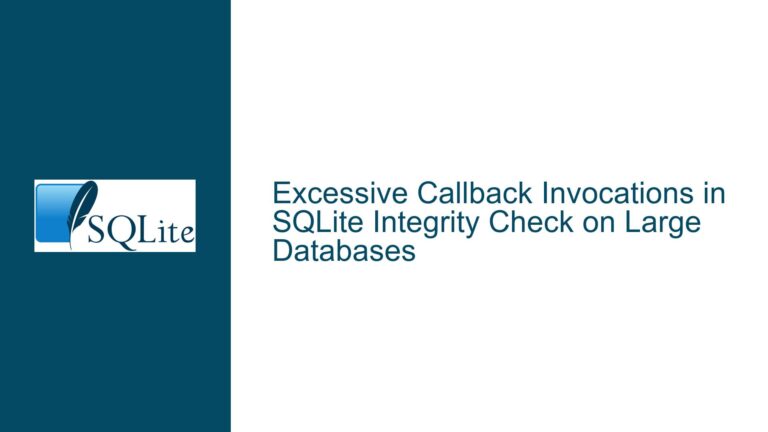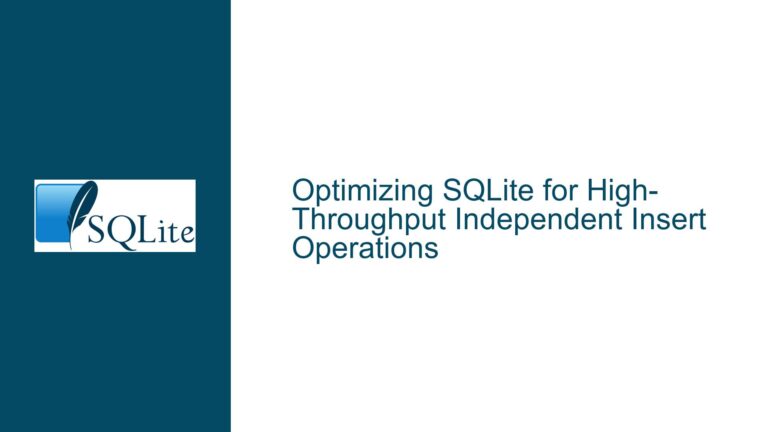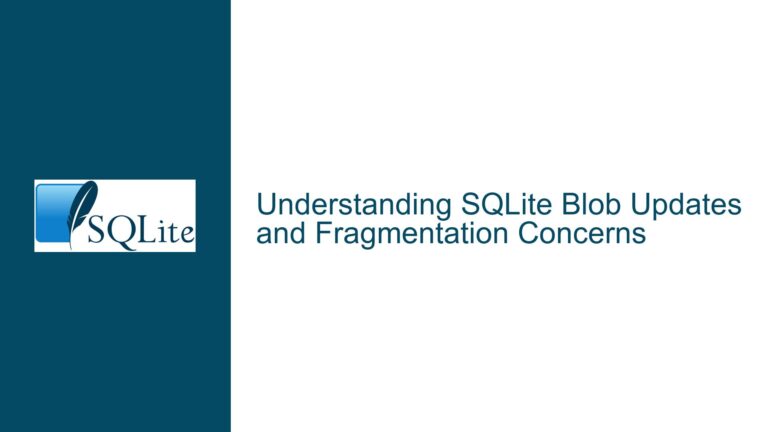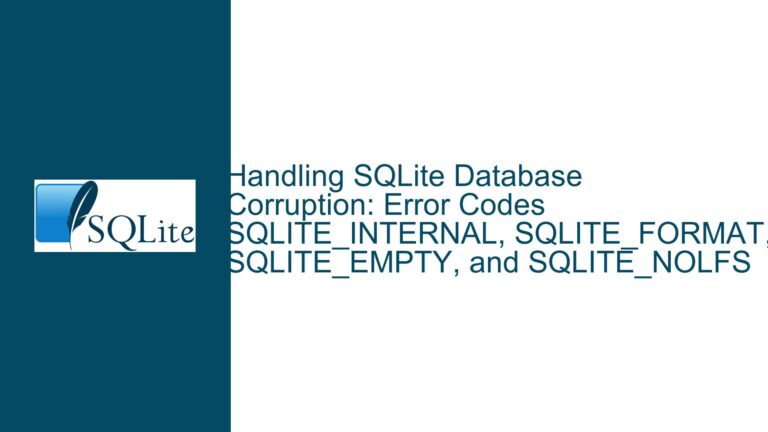Memory Spike in SQLite When Using zeroblob with Trailing Non-Zero Bytes
Memory Allocation Behavior with zeroblob and Trailing Non-Zero Bytes
When working with SQLite, the zeroblob function is a powerful tool for efficiently allocating large blocks of zeroed-out data within a database. However, a common issue arises when a zeroblob is followed by non-zero bytes in the same record. SQLite’s memory optimization strategy for zero bytes at the end of a record does not apply in this scenario, leading to significant memory allocation. This behavior can cause unexpected memory spikes, especially when dealing with large zeroblob sizes.
In the provided example, a table is created with three columns: id, b, and p. The b column is populated with a zeroblob of size 100,256,716 bytes, while the p column contains a binary-encoded file name. The memory profiler indicates that approximately 200 MB of memory is allocated during this operation. This memory spike occurs because SQLite is forced to allocate space for the entire record, including the trailing non-zero bytes in the p column.
SQLite’s optimization for zero bytes at the end of a record is designed to reduce memory usage. When a zeroblob is the last column in a record, SQLite does not allocate memory for the zero bytes, as they can be represented implicitly. However, when non-zero bytes follow the zeroblob, SQLite must allocate memory for the entire blob, including the zero bytes, to ensure that the non-zero bytes are correctly stored. This behavior is a direct consequence of SQLite’s record storage format and its handling of trailing zero bytes.
Interrupted Write Operations Leading to Index Corruption
The memory spike issue is further compounded by the order of columns in the table definition. In the example, the b column (containing the zeroblob) is followed by the p column (containing the binary-encoded file name). This arrangement forces SQLite to allocate memory for the entire zeroblob, as the non-zero bytes in the p column prevent the optimization for trailing zero bytes.
If the columns were reordered so that the zeroblob column is the last column in the record, SQLite could avoid allocating memory for the zero bytes. This reordering would allow SQLite to leverage its optimization for trailing zero bytes, significantly reducing memory usage. For example, if the table were defined as CREATE TABLE t (id INTEGER PRIMARY KEY, p BLOB, b BLOB), the zeroblob in the b column would be the last column in the record, enabling SQLite to optimize memory allocation.
The memory allocation behavior is also influenced by the size of the zeroblob. Larger zeroblob sizes result in proportionally larger memory allocations when non-zero bytes follow the zeroblob. In the example, the zeroblob size is 100,256,716 bytes, which is a substantial allocation. When combined with the trailing non-zero bytes, this results in a memory spike of approximately 200 MB.
Implementing Column Reordering and Memory Optimization Strategies
To address the memory spike issue, several strategies can be employed. The most straightforward solution is to reorder the columns in the table definition so that the zeroblob column is the last column in the record. This reordering allows SQLite to optimize memory allocation for trailing zero bytes, reducing memory usage.
For example, the table definition can be modified as follows:
CREATE TABLE t (id INTEGER PRIMARY KEY, p BLOB, b BLOB)
With this modification, the zeroblob in the b column is the last column in the record, enabling SQLite to avoid allocating memory for the zero bytes. This change can significantly reduce memory usage, especially for large zeroblob sizes.
Another strategy is to minimize the size of the zeroblob when possible. If the application does not require a zeroblob of 100,256,716 bytes, a smaller size can be used to reduce memory allocation. However, this approach may not be feasible for applications that require large zeroblob sizes.
In addition to column reordering and zeroblob size reduction, it is important to consider the overall database schema design. Ensuring that zeroblob columns are positioned as the last columns in records can help optimize memory usage across the entire database. This practice should be applied consistently to all tables that use zeroblob columns.
Finally, it is worth noting that SQLite’s behavior with zeroblob and trailing non-zero bytes is documented, but the implications for memory allocation may not be immediately apparent. Developers should be aware of this behavior and consider it when designing database schemas and writing queries that involve zeroblob columns.
By implementing these strategies, developers can mitigate memory spikes and optimize memory usage when working with zeroblob columns in SQLite. Proper schema design and column ordering are key to leveraging SQLite’s memory optimization features and ensuring efficient database operations.
Detailed Analysis of SQLite’s Memory Allocation Mechanism
To fully understand the memory spike issue, it is essential to delve into SQLite’s memory allocation mechanism. SQLite uses a page-based storage format, where each page contains one or more records. Each record is stored as a contiguous block of bytes, with columns stored in the order defined by the table schema.
When a record is inserted into a table, SQLite allocates memory for the entire record, including all columns. For columns that contain zero bytes, SQLite employs an optimization to avoid allocating memory for those bytes if they occur at the end of the record. This optimization is particularly useful for zeroblob columns, as they consist entirely of zero bytes.
However, when a zeroblob column is followed by a column containing non-zero bytes, SQLite cannot apply this optimization. The presence of non-zero bytes after the zeroblob forces SQLite to allocate memory for the entire zeroblob, including the zero bytes. This behavior is necessary to ensure that the non-zero bytes are correctly stored and can be retrieved without corruption.
The memory allocation behavior can be illustrated with the following example:
CREATE TABLE t (id INTEGER PRIMARY KEY, b BLOB, p BLOB);
INSERT INTO t VALUES (1, zeroblob(100256716), 'filename'.encode());
In this example, the b column contains a zeroblob of size 100,256,716 bytes, and the p column contains a binary-encoded file name. SQLite must allocate memory for the entire zeroblob because the p column contains non-zero bytes that follow the zeroblob.
If the columns are reordered so that the zeroblob column is the last column in the record, SQLite can optimize memory allocation:
CREATE TABLE t (id INTEGER PRIMARY KEY, p BLOB, b BLOB);
INSERT INTO t VALUES (1, 'filename'.encode(), zeroblob(100256716));
In this modified example, the zeroblob in the b column is the last column in the record. SQLite can now avoid allocating memory for the zero bytes, significantly reducing memory usage.
Practical Implications for Database Design and Query Optimization
The memory spike issue has practical implications for database design and query optimization. Developers must be aware of SQLite’s memory allocation behavior when designing schemas and writing queries that involve zeroblob columns. Proper column ordering and schema design can help mitigate memory spikes and optimize memory usage.
When designing a table that includes zeroblob columns, it is advisable to position the zeroblob column as the last column in the record. This positioning allows SQLite to optimize memory allocation for trailing zero bytes, reducing memory usage. For example, consider the following table definition:
CREATE TABLE t (id INTEGER PRIMARY KEY, p BLOB, b BLOB);
In this table, the b column is the last column in the record, enabling SQLite to optimize memory allocation for the zeroblob.
In addition to schema design, developers should consider the size of zeroblob columns when writing queries. If the application does not require a large zeroblob, a smaller size can be used to reduce memory allocation. For example, if the application only needs a zeroblob of 1 MB, the following query can be used:
INSERT INTO t VALUES (1, 'filename'.encode(), zeroblob(1048576));
This query reduces the zeroblob size to 1 MB, significantly reducing memory allocation compared to the original 100,256,716-byte zeroblob.
Developers should also be aware of the potential for memory spikes when working with large zeroblob sizes. If a memory spike occurs, it may be necessary to investigate the table schema and query design to identify opportunities for optimization. Column reordering and zeroblob size reduction are two effective strategies for mitigating memory spikes.
Conclusion
The memory spike issue in SQLite when using zeroblob with trailing non-zero bytes is a result of SQLite’s memory allocation behavior. SQLite optimizes memory usage by avoiding allocation for zero bytes at the end of a record, but this optimization does not apply when non-zero bytes follow a zeroblob. This behavior can lead to significant memory spikes, especially when dealing with large zeroblob sizes.
To mitigate memory spikes, developers should reorder columns in the table schema so that zeroblob columns are the last columns in the record. This reordering allows SQLite to optimize memory allocation for trailing zero bytes, reducing memory usage. Additionally, developers should consider the size of zeroblob columns and minimize their size when possible.
By understanding SQLite’s memory allocation mechanism and implementing these strategies, developers can optimize memory usage and ensure efficient database operations. Proper schema design and query optimization are key to leveraging SQLite’s features and avoiding memory spikes when working with zeroblob columns.
